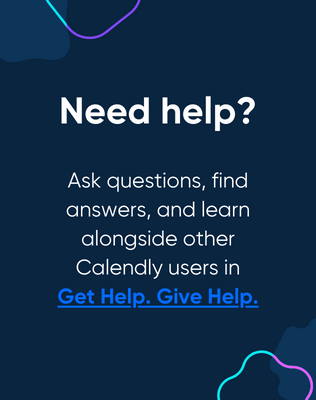Prerequisites and Permissions Needed
To integrate Calendly with Salesforce:
- You must be a Salesforce Admin, or have permission to Author Apex and Modify All Data.
- You must use Salesforce Enterprise edition or higher.
- You must have a Teams or Enterprise account with Calendly
- You must be an Owner or Admin with Calendly
Typically, we recommend connecting the Calendly <> Salesforce integration using a System Administrator account because these will have the required permissions by default. However, sometimes permissions vary or an organization may be security-conscious and want to set up a Profile or Permission Set with the minimum required permissions.
Minimum Required Permissions on Profile Settings:
- API enabled
- View Setup and Configuration
- Access Activities
Major Package Components and Definitions (version 2.6)
To view a complete list of the components, including all new custom fields, visit our Help Center Article.
New Objects:
- CalendlyAction
The CalendlyAction custom object is used to hold event data.
When a meeting is scheduled or canceled, Calendly sends meeting data to Salesforce. Salesforce creates a new CalendlyAction record, which triggers the default CreateEvent flow or CancelEvent flow to run.
For additional information, check out this Help Center article.
- CalendlyLink
The CalendlyLink custom object stores Calendly users email addresses, their Calendly link, and information about the link.
In Salesforce, Calendly will create a CalendlyLink record for every link we send. Once a record for a specific user's link is created, Calendly will update that record on the next hourly sync if necessary.
When the CalendlyLink record is created or updated for a profile link, this triggers the MapCalendlyLinkTemplate flow.
For additional information, check out this Help Center article.
- CalendlyRoutingFormSubmission
The CalendlyRoutingFormSubmission custom object is used to store information, including the name of the form submitted, any UTM parameters or Salesforce ID associated with the form, and the result of the routing rules behind the form.
When a Calendly routing form is submitted, the Salesforce integration creates a CalendlyRoutingFormSubmission record and a CalendlyRoutingFormQuestionsAnswers record for each question asked on the form. The creation of the CalendlyRoutingFormSubmission record triggers the flow CreateRoutingFormLeadTemplate.
For additional information, check out this Help Center article.
- CalendlyRoutingFormQuestionsAnswers
The CalendlyRoutingFormQuestionsAnswers custom object is used to store form questions and answers, and relation to the CalendlyRoutingFormSubmissions object the question/answer is for.
When a Calendly routing form is submitted, the Salesforce integration creates a CalendlyRoutingFormSubmission record and a CalendlyRoutingFormQuestionsAnswers record for each question asked on the form. The creation of the CalendlyRoutingFormSubmission record triggers the flow CreateRoutingFormLeadTemplate.
For additional information, check out this Help Center article.
Flow Templates:
- CreateEventTemplate
When a meeting is scheduled or canceled, Calendly sends meeting data to Salesforce. Salesforce creates a new CalendlyAction record, which triggers the default CreateEvent flow or CancelEvent flow to run.
For additional information, check out this Help Center article.
- CancelEventTemplate
When a meeting is scheduled or canceled, Calendly sends meeting data to Salesforce. Salesforce creates a new CalendlyAction record, which triggers the default CreateEvent flow or CancelEvent flow to run.
For additional information, check out this Help Center article.
- Get Event Attendee Template
When an event is scheduled, the CreateEventTemplate uses the Get Event Attendee Template flow to create a list of attendees in Salesforce.
For additional information, check out this Help Center article.
- Create Event Attendee Template
When an event is scheduled, the CreateEventTemplate uses the Create Event Attendee Template flow to create a list of attendees in Salesforce.
For additional information, check out this Help Center article.
- MapUserCalendlyLinkTemplate
In Salesforce, Calendly will create a CalendlyLink record for every link we send. Once a record for a specific user's link is created, Calendly will update that record on the next hourly sync if necessary.
When the CalendlyLink record is created or updated for a profile link, this triggers the MapCalendlyLinkTemplate flow.
For additional information, check out this Help Center article.
- CreateRoutingFormLeadTemplate
When a Calendly routing form is submitted, the Salesforce integration creates a CalendlyRoutingFormSubmission record and a CalendlyRoutingFormQuestionsAnswers record for each question asked on the form. The creation of the CalendlyRoutingFormSubmission record triggers the flow CreateRoutingFormLeadTemplate.
For additional information, check out this Help Center article.
How to install the Calendly package in Salesforce
- In Calendly, visit your Integrations page and select Salesforce.
- Select Integrate Now.
Note: To test and customize your setup before going live, you can connect your Salesforce sandbox (see this Help Center article)
- Enter your Salesforce credentials, and select Log In.
- Select allow access.
- Select Install the Calendly package, and select Install for All Users. Select Install.
- Once installation is complete, select Done.
 Once the package is installed, make sure to return to Calendly and select refresh to complete the connection between Calendly and Salesforce.
Once the package is installed, make sure to return to Calendly and select refresh to complete the connection between Calendly and Salesforce.
Note: If you see an error during installation, you may be using the Group or Professional edition of Salesforce. Your Salesforce edition must be Enterprise or higher to integrate via web service API. For other common errors and troubleshooting steps, see here.

